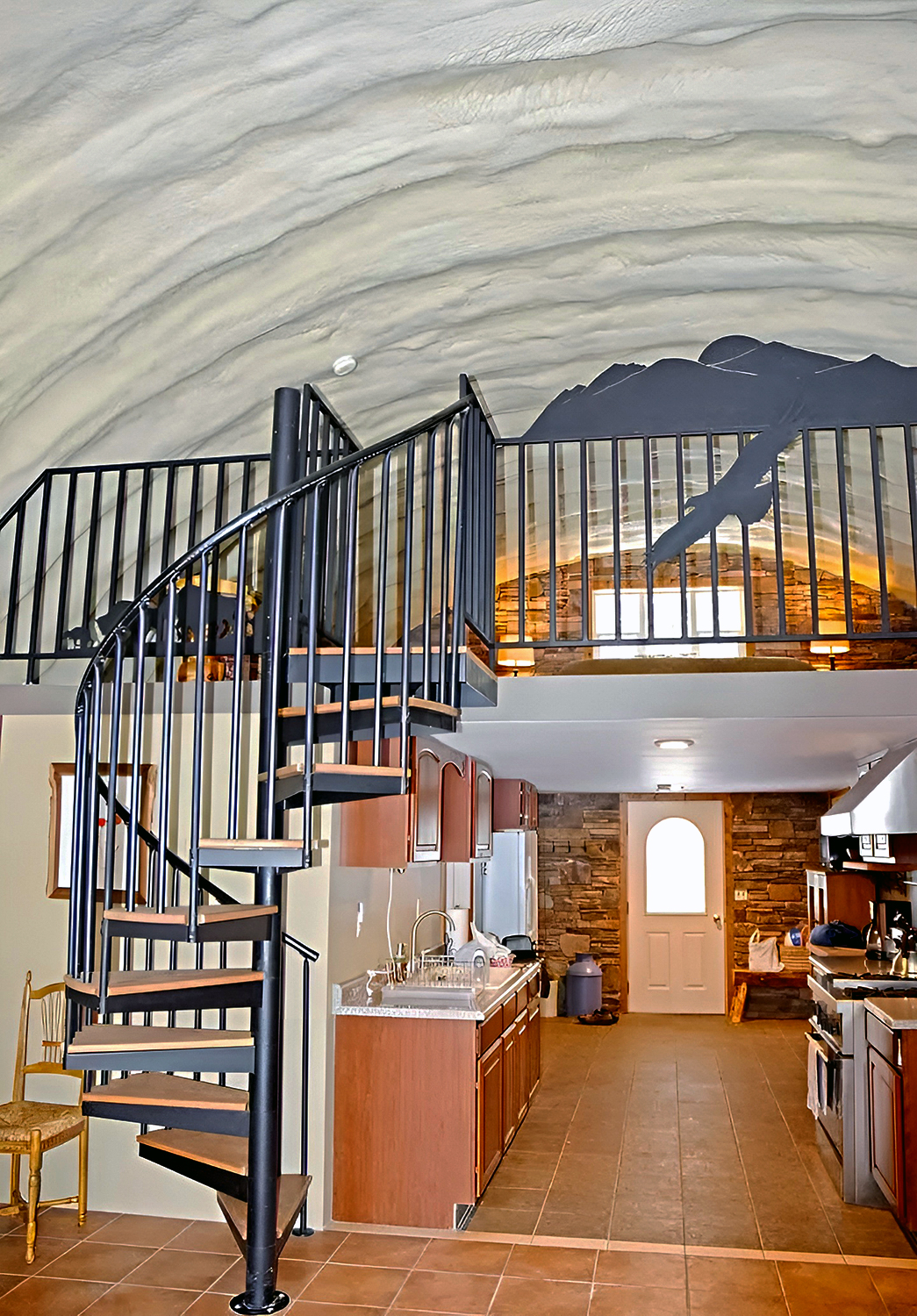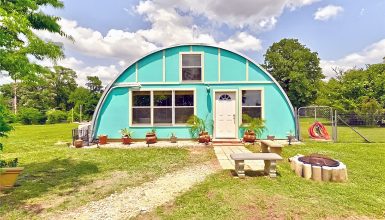Ever step inside a Quonset hut home in the middle of summer or winter and feel like you just walked into an oven—or an icebox? Don’t worry, you’re not alone! Quonset huts are famous for their iconic arched roofs and super-strong steel walls. But that same metal shell can turn your dream home into a sweat lodge or a freezer—unless you pick the right insulation. Let’s dive in!
1. Spray Foam Insulation
If you want the ultimate in comfort and energy savings, spray foam insulation is the top choice for Quonset hut homes. Why? Because it hugs every curve and corner of that iconic steel arch.
Spray foam insulation is a liquid that expands into a thick, solid foam when sprayed onto a surface. It fills every gap, nook, and cranny, creating a continuous layer of protection.
Why Is It Great for Quonset Huts?
- Perfect Fit: The foam molds itself right to the inside of the arched roof and walls. No cutting, bending, or squeezing.
- High R-Value: R-value measures how well insulation blocks heat and cold. Spray foam packs a punch, giving you more protection per inch than almost any other type.
- Air and Moisture Barrier: It seals out drafts and moisture, helping to stop rust and condensation on your metal walls.
- All-in-One: You don’t need extra vapor barriers or radiant barriers—spray foam does it all.
Things to Know
- Cost: Spray foam is usually the most expensive option upfront. But it pays you back with lower energy bills and less maintenance.
- Professional Install: This isn’t a weekend DIY job. Hire a pro for the best results and safety.
- Quick Tip: Open-cell spray foam is softer and cheaper, but closed-cell is denser, adds more strength, and is more waterproof—perfect for metal buildings.
2. Rigid Foam Board
Not ready for spray foam? Rigid foam board is another great way to insulate your Quonset hut. It’s easy to work with and fits most budgets.
These are lightweight panels made from materials like polystyrene or polyisocyanurate. You buy them in big sheets and cut them to fit your space.
Why Is It Great for Quonset Huts?
- High R-Value: Like spray foam, foam boards deliver a lot of insulation per inch.
- DIY-Friendly: You can cut and glue or screw these panels right onto the inside of your metal walls.
- Moisture Resistant: Foam board won’t soak up water, which means less risk of mold or rust.
Things to Know
- Fitting the Curve: Quonset huts have a rounded shape. Flat foam boards don’t naturally bend, so you may need to use thinner boards, score the back, or layer small panels to follow the curve.
- Gaps and Seams: For the best results, seal every seam with tape or spray foam to prevent air leaks.
- Finishing Touches: Many people add wood framing over the foam board and then cover it with drywall or paneling for a polished look.
3. Batt or Blanket Insulation
If you’ve ever watched a home renovation show, you’ve seen batt insulation—those big rolls of fluffy fiberglass or mineral wool. It’s a classic, affordable option, but it’s not always the easiest for Quonset huts.
This is insulation that comes in long, flexible sheets or rolls. You cut it to length and fit it between wall studs or roof rafters.
Why Is It Sometimes Good for Quonset Huts?
- Budget-Friendly: This is one of the least expensive options.
- Easy to Find: Every home store carries it in many thicknesses and types.
- Works with Framing: If you add wood or metal framing to your hut, you can tuck batt insulation right between the studs.
Things to Know
- Not Curve-Friendly: Batt insulation is meant for flat walls. It doesn’t bend easily, so it can leave gaps or sag on curved surfaces.
- Moisture Matters: If batt insulation gets wet, it loses its power and can trap moisture against your metal walls, leading to rust or mold.
- Extra Steps: You’ll need to add a vapor barrier to protect your hut—and make sure everything is sealed tight.
Tip: Batt insulation is best if you’re finishing the inside with straight walls and ceilings. If you want to keep that exposed Quonset curve, try another option.
4. Spray-On Ceramic Insulation
Ever heard of insulating paint? Spray-on ceramic insulation is a little different from the rest, but it can work wonders in the right situation.
This is a paint-like coating filled with tiny ceramic beads. You spray or brush it right onto your metal walls, inside or out.
Why Is It Great for Quonset Huts?
- Super Easy: Just spray or roll it on like regular paint. No measuring, cutting, or gluing.
- Follows Every Curve: The paint hugs every curve and corner of your Quonset hut, leaving no spot uncovered.
- Fights Heat and Condensation: It reflects heat and helps prevent condensation—important for metal homes in hot or humid areas.
Things to Know
- Not a Standalone Solution: This paint adds a little insulation, but it won’t replace regular insulation if you want a truly cozy home.
- Best as a Booster: Use ceramic spray as a top layer over foam board or batt insulation for extra protection.
- Great for DIY: Anyone can use it, and it’s perfect for hard-to-reach spots.
5. Reflective Foil Insulation
If your Quonset hut bakes in the sun, reflective foil insulation is a must-have. It’s simple but effective—especially when used with other insulation.
It’s basically a shiny sheet (or bubble wrap with foil faces) that reflects radiant heat away from your home.
Why Is It Great for Quonset Huts?
- Flexible: You can staple, glue, or tape it right to the curved steel walls or rafters.
- Blocks Heat: In hot climates, foil insulation reflects sunlight and heat before it can even warm up your hut.
- Lightweight: It’s thin, light, and easy to install, even on high or awkward surfaces.
Things to Know
- Needs an Air Gap: To work best, radiant barriers need a small air space on at least one side. This boosts their power to reflect heat.
- Not for Winter Alone: Reflective foil doesn’t do much for cold weather—combine it with foam or batt insulation for all-season comfort.
- Affordable: This is one of the most budget-friendly ways to keep heat out.
6. Blown-In Insulation
Got odd-shaped spaces or finished walls in your Quonset hut? Blown-in insulation might be your answer.
This insulation is made of small loose fibers (like fiberglass, cellulose, or mineral wool) that get “blown” into walls, ceilings, or cavities with a special machine.
Why Is It Great for Quonset Huts?
- Retrofit Ready: It’s perfect if you already finished your walls but want to add insulation later.
- Fills Gaps: Blown-in material finds its way into every tiny space for complete coverage.
- Good R-Value: It provides strong protection, especially when installed at the right depth.
Things to Know
- Needs a Cavity: Blown-in insulation needs an enclosed space—like between two walls or in an attic floor.
- Professional Job: You’ll need special equipment, so most homeowners hire a pro.
- Can Settle: Over time, the insulation may settle, so you might need to top it up after several years.
5 Pro Tips for Insulating a Quonset Hut Home
Now that you know the main insulation options, here are some handy tips to make your project even smoother:
1. Always Use a Vapor Barrier
Metal buildings sweat! A vapor barrier stops moisture from sneaking in, which keeps your insulation dry and your walls rust-free.
2. Don’t Forget the Roof
Heat rises—so does air conditioning! Insulate your roof as carefully as your walls. For Quonset huts, the roof and wall are one big curve, so you’re covering both at once.
3. Seal Every Crack and Gap
Air leaks can ruin even the best insulation job. Use spray foam, caulk, or special tape to seal every seam, corner, and gap.
4. Plan Your Interior
Think about how you want the inside to look. If you love the curved steel look, go with spray foam or foam board. If you want straight, framed walls, batt insulation is easy to use.
5. Climate Counts
Live somewhere hot? Focus on radiant barriers and ventilation. Cold climate? Go for thicker insulation and make sure every seam is sealed.
Final Thoughts
Insulating your Quonset hut is more than just a home improvement project—it’s the key to comfort, energy savings, and loving your home in every season. Whether you go for spray foam, rigid board, batt insulation, or something else, the right choice makes all the difference.
Remember, there’s no one-size-fits-all answer. Think about your climate, your budget, your DIY skills, and your dream home style. And if you ever get stuck, ask a local pro for advice—they’ve seen it all before!
So go ahead—pick the insulation that suits you best, roll up your sleeves (or call the experts), and get ready to enjoy a Quonset hut home that feels just right, all year long.








